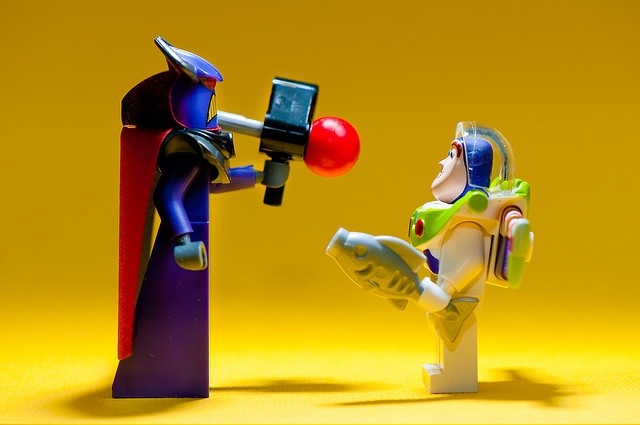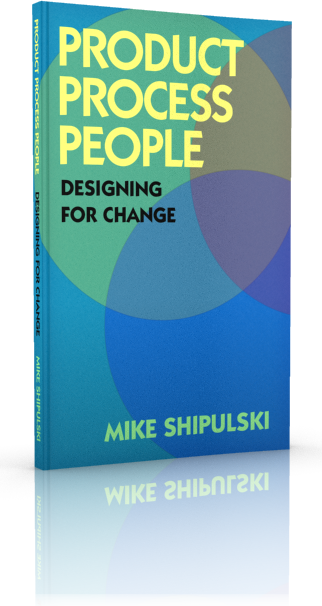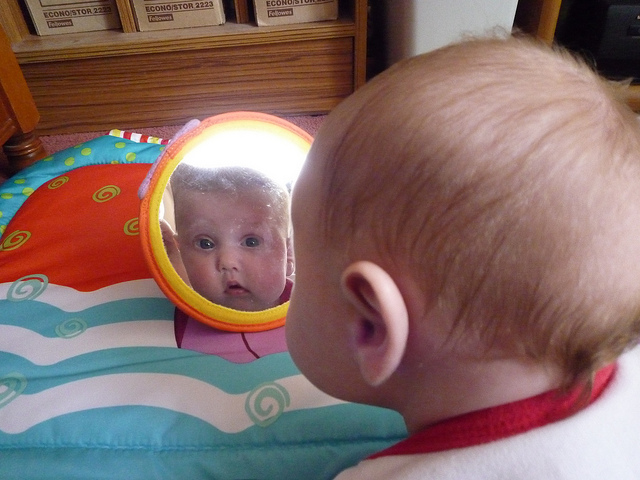Archive for the ‘The Future’ Category
The Half-Life of Our Maps
 The early explorers had maps, but they were wrong – sea monsters, missing continents, and the home country at the center. Wrong, yes, but the best maps of their day. The early maps weren’t right because the territory was new, and you can expect the same today. When you work in new territory, your maps are wrong.
The early explorers had maps, but they were wrong – sea monsters, missing continents, and the home country at the center. Wrong, yes, but the best maps of their day. The early maps weren’t right because the territory was new, and you can expect the same today. When you work in new territory, your maps are wrong.
As the explorers’ adventures radiated further from home, they learned and their maps improved. But still, the maps were best close to home and diverged at the fringes. And over the centuries the radius of rightness grew and the maps converged on the territory. And with today’s GPS technology, maps are dead on. The system worked – a complete map of everything.
Today you have your maps of your business environment and the underlying fundementals that ground them. Like the explorers you built them over time and checked them along the way. They’re not perfect (more right close to home) but they’re good. You mapped the rocks, depths, and tides around the trade routes and you stay the course because the routes have delivered profits and they’re safe. You can sail them in your sleep, and sometimes you do.
But there’s a fundamental difference between the explorers’ maps and yours – their territory, the physical territory, never changed, but yours is in constant flux. The business trade winds shift as new technologies develop; the size of continents change as developing countries develop; and new rocks grow from the sea floor as competitors up their game. Just when your maps match the territory, the territory changes around you and diverges from your maps, and your maps become old. The problem is the maps don’t look different. Yes, they’re still the same maps that guided you safely along your journey, but they no longer will keep you safely off the rocks and out of the Doldrums.
But as a new age explorer there’s hope. With a healthy skepticism of your maps, frequently climb the mast and from the crow’s nest scan the horizon for faint signs of trouble. Like a thunder storm just below the horizon, you may not hear trouble coming, but there’ll be dull telltale flashes that flicker in your eyepiece. Not all the crew will see them, or want to see them, or want to believe you saw them, so be prepared when your report goes unheeded and your ship sales into the eye of the storm.
Weak signals are troubling for several reasons. They’re infrequent and unpredictable which makes them hard to chart, and they’re weak so they’re tough to hear and interpret. But worst of all is their growth curve. Weak signals stay weak for a long time until they don’t, and when they grow, they grow quickly. A storm just over the horizon gives weak signals right up until you sail into gale force winds strong enough to capsize the largest ships.
Maps are wrong when the territory is new, and get more right as you learn; but as the territory changes and your learning doesn’t, maps devolve back to their natural wrongness. But, still, they’re helpful. And they’re more helpful when you remember they have a natural half-life.
My grandfather was in the Navy in World War II, though he could never bring himself to talk about it. However, there was one thing he told me, a simple saying he said kept him safe:
Red skies at night, sailor’s delight; red skies in morninng, sailor takes warning.
I think he knew the importance of staying aware of the changing territory.
Decide To Tackle The Impossible
 Doing the impossible doesn’t take a long time, starting does. More precisely, what takes a long time is getting ready to start. Getting ready is the gating item. So what’s in the way?
Doing the impossible doesn’t take a long time, starting does. More precisely, what takes a long time is getting ready to start. Getting ready is the gating item. So what’s in the way?
The big deal about starting is other people will see you do it and they’ll judge you. Your brain tells stories about how people will think you’re silly or incompetent for trying the outrageous. It takes a long time to build the courage to start. But where starting is scary, getting ready is safe and comfortable. Getting ready is done in the head – it’s a private process. And because you do it in your head, you can do it without being judged, and you can do it for as long as you like. And you can take comfort in getting ready because you rationalize you’re advancing the ball with your thinking. (Hey, at least you’re thinking about it.) But the real reason for staying in the getting ready domain is starting the fear around being judged for starting.
After you finally mustered the courage to start, you’ll get welcomed with all sorts of well-intentioned, ill-informed criticism. The first one – We tried that before, and it didn’t work. Thing is, it was so long ago no one remembers what was actually tried. Also, no one remembers how many approaches were tried, and even fewer know why it didn’t work. But, everyone’s adamant it won’t work because it didn’t work. Your response – That was a long time ago, and things have changed since then. There are new technologies to try, new materials that may work, new experimental methods, and new analytical methods to inform the work.
Now that you dismissed the we-already-tried-that’s, the resource police will show up at your door. They’ll say – That’s a huge project and it will consume all our resources. You can’t do that. Your response – Well, I’m not eating the whole enchilada, I only taking the right first bite. And for that, I don’t need any extra resources. You see, my friends and I really want to do this and we pooled our resources and narrowly defined the first bite. So, as far as resources, I’m all set.
Now the alignment officers will find you. They’ll say – Your off-topic mission impossible will confuse and distract our organization and we can’t have that. You know there’s no place for passion and excitement around here. Can you imagine engineers running around doing things that could disrupt our decrepit business model? We’ll no longer have control, and we don’t like that. Please stop. Your response – Let’s set up a meeting with the CEO who’s on the hook to create new businesses, and you can deliver that message face-to-face. You want me to set up the meeting?
Lastly, the don’t-rock-the-boaters will nip at your heels. They’ll say – Things are going pretty well. Did you hear we’re laying off fewer people this quarter? And, we’re losing less money this quarter. Things are looking up. And here you are trying something new, and scaring everyone half to death. You’ve got to stop that nonsense. Your response – Though it may be scary, I have a hunch this crazy stuff could create a whole new business and help secure the company’s future. And I have kids going to college in a couple years, and the company’s future is important to me.
When doing the impossible, the technical part is the easy part. Once you decide to try, what you thought impossible comes quickly. What’s difficult is the people part. Doing the impossible is unpredictable, and it cuts across grain of our culture of predictability. For years it’s been well defined projects with guaranteed profits and completion dates etched in stone. And after years of predictability injections people become the antibodies that reject the very work the company needs – the work that delivers the impossible.
No kidding – once you start the impossible, your organization will make it difficult for you. But, that’s nothing compared to the difficulty of getting ready because in that phase, you must overcome the most powerful, sly, dangerous critic of all – yourself.
Letting Go Of Last Year
Last year is gone, and going forward things will be different. Last year’s you is gone, and going forward you will be different. That’s the thing – everything changes. Regardless if last year was enjoyable or terrible, no matter. This year will be different. You can try to hold on to it, but all you’ll get is rope burns. Or, you can take comfort in the impermanence.
Your company is different; your competitors are different; your customers are different. In fact, everything is different. And what you did last year won’t get the same response today. Yet we hold on. It’s difficult to see things as they are when there’s so much comfort in seeing things as they were. Even if things weren’t so good last year, there’s comfort in seeing things as they were.
Toughest of all is to see yourself as you are. (I’m not talking about the body stuff – older, grayer, more wrinkles – that’s easy to see. I’m talking about the inside stuff.) On the inside, you are not what you were last year. You don’t have to know how you are different; just take comfort that you are different. Take comfort that right here, right now, as you sit, you are different, and so is everything else.
It’s difficult to plan out how things will go this year; and it’s impossible to predict how you’ll grow. Things will change; you will change; and putting yourself in that frame of mind can be helpful.
At the New Year, take time to celebrate the upcoming impermanence that will surely find you.
Photo from free HDR Photos – www.freestock.ca
Weak Signals And The Radical Fringe
We strive to get everyone on the same page, to align the crew in a shared direction. The thinking goes – If we’re all pulling in the same direction, we’ll get there faster and more efficiently. Yes, the destination will come sooner, but what if it’s not there when we get there?
There’s implicit permanence to our go-forward travel plans. We look out three years and plan our destination as if today’s rules and fundamentals will still apply. We think – That imaginary tropical vacation spot will be beautiful in three years because it looks beautiful through the kalidascope of today’s success. But as the recent natural disasters have taught us, whole islands can be destroyed in an instant. But still, the impermenance of today’s tried-and-true business models is lost on us, and we see the unknowable future as statically as the unchangeable map of the continents.
Thing is, all around us there are weak indications the fundamental tradewinds have started to shift – weak signals of impermenance that may invalidate today’s course heading. But weak signals are difficult to hear – the white noise of yesterday’s success drowns out the forward-looking weak signals. And more problematic, once heard, weak signals are easily dismissed because their song threatens the successful status quo.
You feel weak signals in your chest. It could be a weak signal when your experience tells you things should go one way and they actually go another. Martin Zwilling (Forbes) has some great examples. (Thanks to Deb Mills-Scofield [@dscofield] for retweeting the article.)
100% alignment reduces adaptability because it deadens us to weak signals, and that’s a problem in these times of great impermanence. To counter the negative elements of alignment, there must be a balancing injection of healthy misalignment. This is an important and thankless task falls on the shoulders of a special breed – the radical fringe. They’re the folks smart enough to knit disjointed whispers into coherent ideas that could unravel everything and brave enough to test them.
Disruptive movements and revolutions build momentum quietly and slowly. But if you can recognize them early, there’s a chance you can get into position to ride their tsunami instead of being ambushed and scuttled by it. But you’ve got to listen closely because these young movements are stealthy and all they leave in their wake are weak signals.
Tracking Toward The Future
 It’s difficult to do something for the first time. Whether it’s a new approach, a new technology, or a new campaign, the mass of the past pulls our behavior back toward itself. And sadly, whether the past has been successful or not, its mass, and therefore it’s pull, are about the same. The past keeps us along the track of sameness.
It’s difficult to do something for the first time. Whether it’s a new approach, a new technology, or a new campaign, the mass of the past pulls our behavior back toward itself. And sadly, whether the past has been successful or not, its mass, and therefore it’s pull, are about the same. The past keeps us along the track of sameness.
Trains have tracks to enable them to move efficiently (cost per mile), and when you want to go where the train is heading, it’s all good. But when the tracks are going to the wrong destination, all that efficiency comes at the expense of effectiveness. Like we’re on rails, company history keeps us on track, even if it’s time for a new direction.
The best trains run on a ritualistic schedule. People queue up at same time every morning to meet their same predictable behemoth, and take comfort in slinking into their regular seats and turning off their brains. And this is the train’s trick. It uses its regularity to lull riders into a hazy state of non-thinking – get on, sit down, and I’ll get your there – to blind passengers from seeing its highly limited timetable and its extreme inflexibility. The train doesn’t want us to recognize that it’s not really about where the train wants to go.
Trains are powerful in their own right, but their real muscle comes from the immense sunk cost of their infrastructure. Previous generations invested billions in train stations, repair facilities, tight integration with bus lines, and the tracks, and it takes extreme strength of character to propose a new direction that doesn’t make use of the old, tired infrastructure that’s already paid for. Any new direction that requires a whole new infrastructure is a tough sell, and that’s why the best new directions transcend infrastructure altogether. But for those new directions that require new infrastructure, the only way to go is a modular approach that takes the right size bites.
Our worn tracks were laid in a bygone era, and the important destinations of yesteryear are no longer relevant. It’s no longer viable to go where the train wants; we must go where we want.
Less Before More – Innovation’s Little Secret
 The natural mindset of innovation is more-centric. More throughput; more performance; more features and functions; more services; more sales regions and markets; more applications; more of what worked last time. With innovation, we naturally gravitate toward more.
The natural mindset of innovation is more-centric. More throughput; more performance; more features and functions; more services; more sales regions and markets; more applications; more of what worked last time. With innovation, we naturally gravitate toward more.
There are two flavors of more, one better than the other. The better brother is more that does something for the first time. For example, the addition of the first airbags to automobiles – clearly an addition (previous vehicles had none) and clearly a meaningful innovation. More people survived car crashes because of the new airbags. This something-from-nothing more is magic, innovative, and scarce.
Most more work is of a lesser class – the more-of-what-is class. Where the first airbags were amazing, moving from eight airbags to nine – not so much. When the first safety razors replaced straight razors, they virtually eliminated fatal and almost fatal injuries, which was a big deal; but when the third and fourth blades were added, it was more trivial than magical. It was more for more’s sake; it was more because we didn’t know what else to do.
While more is more natural, less is more powerful. The Innovator’s Dilemma clearly called out the power of less. When the long-in-the-tooth S-curve flattens, Christensen says to look down, to look down and create technologies that do less. Actually, he tells us someone will give ground on the very thing that built the venerable S-curve to make possible a done-for-the-first-time innovation. He goes on to say you might as well be the one to dismantle your S-curve before a somebody else beats you to it. Yes, a wonderful way to realize the juciest innovation is with a less-centric mindset.
The LED revolution was made possible with less-centric thinking. As the incandescent S-curve hit puberty, wattage climbed and more powerful lights became cost effective; and as it matured, output per unit cost increased. More on more. And looking down from the graying S-curve was the lowly LED, whose output was far, far less.
But what the LED gave up in output it gained in less power draw and smaller size. As it turned out, there was a need for light where there had been none – in highly mobile applications where less size and weight were prized. And in these new applications, there was just a wisp of available power, and incandesent’s power draw was too much. If only there was a technology with less power draw.
But at the start, volumes for LEDs were far less than incandesent’s; profit margin was less; and most importantly, their output was far less than any self-respecting lightbulb. From on high, LEDs weren’t real lights; they were toys that would never amount to anything.
You can break intellectual inertia around more, and good things will happen. New design space is created from thin air once you are forced from the familiar. But it takes force. Creative use of constraints can help.
Get a small team together and creatively construct constraints that outlaw the goodness that makes your product great. The incandescent group’s constraint could be: create a light source that must make far less light. The automotive group’s constraint: create a vehicle that must have less range – battery powered cars. The smartphone group: create a smartphone with the fewest functions – wrist phone without Blutooth to something in your pocket , longer battery life, phone in the ear, phone in your eyeglasses.
Less is unnatural, and less is scary. The fear is your customers will get less and they won’t like it. But don’t be afraid because you’re going to sell to altogether different customers in altogether markets and applications. And fear not, because to those new customers you’ll sell more, not less. You’ll sell them something that’s the first of its kind, something that does more of what hasn’t been done before. It may do only a little bit of that something, but that’s far more than not being able to do it all.
Don’t tell anyone, but the next level of more will come from less.
Choose Yourself
 We’ve been conditioned to ask for direction; to ask for a plan; and ask for permission. But those ways no longer apply. Today that old behavior puts you at the front of the peloton in the great race to the bottom.
We’ve been conditioned to ask for direction; to ask for a plan; and ask for permission. But those ways no longer apply. Today that old behavior puts you at the front of the peloton in the great race to the bottom.
The old ways are gone.
Today’s new ways: propose a direction (better yet, test one out on a small scale); create and present a radical plan of your own (or better, on the smallest of scales test the novel aspects and present your learning); and demonstrate you deserve permission by initiating activity on something that will obsolete the very thing responsible for your success.
People that wait for someone to give them direction are now a commodity, and with commodities it always ends in the death spiral of low cost providers putting each other out of business. As businesses are waist deep in proposals to double-down on what hasn’t worked and are choking on their flattened S-curves, there’s a huge opportunity for people that have the courage to try new things on their own. Today, if you initiate you’ll differentiate.
[This is where you say to yourself – I’ve already got too much on my plate, and I don’t have the time or budget to do more (and unsanctioned) work. And this is where I tell you your old job is already gone, and you might as well try something innovative. It’s time to grab the defibrillator and jolt your company out of its flatline. ]
It’s time to respect your gut and run a low cost, micro-experiment to test your laughable idea. (And because you’ll keep the cost low, no one will know when it doesn’t go as you thought. [They never do.]) It’s time for an underground meeting with your trusted band of dissidents to plan and run your pico-experiment that could turn your industry upside down. It’s time to channel your inner kindergartener and micro-test the impossible.
It’s time to choose yourself.
What Aren’t You Doing?
You’re busier than ever, and almost every day you’re asked to do more. And usually it’s more with less – must improve efficiency so you can do more of what you already do. We want you to take this on, but don’t drop anything.
Improving your efficiency is good, and it’s healthy to challenge yourself to do more, but there’s a whole other side to things – a non-efficiency-based approach, where instead of asking how can you do more things, it’s about how you can do things that matter more.
And from this non-efficiency-based framework, the question “What aren’t you doing?” opens a worm hole to a new universe, and in this universe meaning matters. In this universe “What aren’t you doing?” is really “What aren’t you doing that is truly meaningful to you?”
[But before I’m accused of piling on the work, even if it’s meaningful work, I’ll give you an idea to free up time do more things that matter. First, change your email settings to off-line mode so no new messages pop on your screen and interrupt you. In the morning manually send and receive your email and answer email for 30 minutes; do the same in the afternoon. This will force you to triage your email and force you to limit your time. This will probably free up at least an hour a day.]
Now we’ll step through a process to figure out the most important thing you’re not doing.
Here is a link to a template to help you with the process — Template – What Aren’t You Doing.
The first step is to acknowledge there are important things you’re not doing and make a list. They can be anything – a crazy project, a deeper relationship, personal development, an adventure, or something else.
To make the list, ask these questions:
I always wanted to ____________.
I always wished I could __________.
Write down your answers. Now run the acid test to make sure these things are actually meaningful. Ask yourself:
When I think of doing this thing, do I feel uncomfortable or or a little scared?
If they don’t make you a little uncomfortable, they’re not meaningful. Go back to the top and start over. For the ones that make you uncomfortable, choose the most important, enter it in the template, and move to the next step.
In the second step you acknowledge there’s something in the way. Ask yourself:
I can’t do my most meaningful thing because _______________.
Usually it’s about time, money, lack of company support, goes against the norm, or it’s too crazy. On the template write down your top two or three answers.
In the third step you transform from an external focus to an internal one, and acknowledge what’s in the way is you. (For the next questions you must temporarily suspend reality and your very real day-to-day constraints and responsibilities.) Ask yourself:
If I started my most meaningful thing tomorrow I would feel uncomfortable that ____________.
Write down a couple answers, then ask:
The reason I would feel uncomfortable about my most meaningful thing is because I __________. (Must be something about you.)
Write down one or two. Some example reasons: you think your past experiences predict the future; you’re afraid to succeed; you don’t like what people will think about you; or the meaningful stuff contradicts your sense of self.
Spend an hour a week on this exercise until you understand the reasons you’re not doing your most meaningful thing. Then, spend an hour a week figuring out how to overcome your reasons for not doing. Then, spend an hour a week, or more, doing your most meaningful thing.
Celebrating Four Years!
 Today is a celebration – four years of Shipulski On Design!
Today is a celebration – four years of Shipulski On Design!
To celebrate, I’m introducing my new book — Product Process People – Designing for Change.
And as a gift, I’m offering for free (pdf format) to my subscribers. If you’re a subscriber, click below to download the pdf. If you’re not a subscriber and you want the book, simply subscribe to my blog (see the box on the right) and download the pdf. (It’s the honor system.)
[wpdm_file id=3] Download it, read it, and share it with all your friends. (They don’t have to subscribe because you do.)
I hope the book helps you have a meaningful discussion about the future.
And for me, to help spread the message, if you download it please share it.
Thanks for reading, and I look forward to a great year 5.
Mike
Moving From Kryptonite To Spinach
 With websites, e-books, old fashioned books, Twitter, LinkedIn, Facebook, and blogs, there’s a seemingly limitless flood of information on every facet of business. There are heaps on innovation, new product development, lean, sales and marketing, manufacturing, and strategy; and within each there are elements and sub elements that fan out with multiple approaches.
With websites, e-books, old fashioned books, Twitter, LinkedIn, Facebook, and blogs, there’s a seemingly limitless flood of information on every facet of business. There are heaps on innovation, new product development, lean, sales and marketing, manufacturing, and strategy; and within each there are elements and sub elements that fan out with multiple approaches.
With today’s search engines and bots to automatically scan the horizon, it’s pretty easy to find what you’re looking for especially as you go narrow and deep. If you want to find best practices for reducing time-to-market for products designed in the US and manufactured in China, ask Google and she’ll tell you instantly. If you’re looking to improve marketing of healthcare products for the 20 to 40 year old demographic of the developing world, just ask Siri.
It’s now easy to separate the good stuff from the chaff and focus narrowly on your agenda. It’s like you have the capability dig into a box of a thousand puzzle pieces and pull out the very one you’re looking for. Finding the right puzzle piece is no longer the problem, the problem now is figuring out how they all fit together.
What holds the pieces together? What’s the common thread that winds through innovation, sales, marketing, and manufacturing? What is the backplane behind all this business stuff?
The backplane, and first fundamental, is product.
Every group has their unique work, and it’s all important – and product cuts across all of it. You innovate on product; sell product; manufacture product; service product. The shared context is the product. And I think there’s opportunity to use the shared context, this product lens, to open up design space of all our disciplines. For example how can the product change to make possible new and better marketing? How can the product change to radically simplify manufacturing? How can the product change so sales can tell the story they always wanted to tell? What innovation work must be done to create the product we all want?
In-discipline improvements have been good, but it’s time to take a step back and figure out how to create disruptive in-discipline innovations; to eliminate big discontinuities that cut across disciplines; and to establish multidisciplinary linkages and alignment to power the next evolution of our businesses. New design space is needed, and the product backplane can help.
Use the product lens to look along the backplane and see how changes in the product can bridge discontinuities across sales, marketing, and engineering. Use the common context of product to link revolutionary factory simplification to changes in the product. Use new sensors in the product to enable a new business model based on predictive maintenance. Let your imagination guide you.
It’s time to see the product for more than what it does and what it looks like. It’s time to see it as Superman’s kryptonite that constrains and limits all we do that can become Popeye’s spinach that can strengthen us to overpower all obstacles.
Self-Perspective Using Mental Time Travel
 If you’re sitting in the present, you’re sitting in a good place – you’re more mindful of what’s going on, more aware of your thinking, and more thoughtful of your actions. But there’s one thing sitting in the present can’t provide, and that’s perspective. To create perspective, to understand the hows and whys of your journey to the present, requires reflection on the past. But to self reflect without distorting the image requires separation from your present.
If you’re sitting in the present, you’re sitting in a good place – you’re more mindful of what’s going on, more aware of your thinking, and more thoughtful of your actions. But there’s one thing sitting in the present can’t provide, and that’s perspective. To create perspective, to understand the hows and whys of your journey to the present, requires reflection on the past. But to self reflect without distorting the image requires separation from your present.
Here’s an idea to create separation – an exercise in mental time travel where your past becomes your present and your present becomes your future. It goes like this: Set your mental way-back machine for five years ago, turn the crank and jump back to a five-years-ago present. From your seat in your new present (your past), erase your future (your present) to open it up to unlimited possibilities. Now, imagine a future (one of the infinite possible futures) that is identical to the one that actually happened. (But remember, you don’t know it happened, so it’s only a potential future state.) Okay. You’re now ready to mint your own perspective.
From your seat in your new present (your past), ask yourself three questions.
If your imagined future (your actual present state) came to be:
- How would you feel about your relationships with your friends, your community, and your family?
- How would you feel about your health?
- How would you feel about the alignment between your actions, values, and passions?
With your answers in hand (and I suggest you actually write them down), use your way-back machine to jump forward to the present present. Sitting in the present (the real one), read your answers (written five years ago) to the three questions above.
How do you feel about your answers? What do you like about your answers? What makes you uncomfortable? What surprised you? Write down your answers because that’s the unfiltered perspective you were looking for.
Now the valuable part – two final questions (write down the actual answers):
Taking guidance from your newly self-minted perspective:
- Going forward, while sitting in the present, what will you do more of?
- Going forward, while sitting in the present, what will you do less of?
If you are sufficiently intrigued (or confused) to try the exercise and find value in it, please pay it forward and share it with others.
And don’t forget to repeat the process every year.



 Mike Shipulski
Mike Shipulski